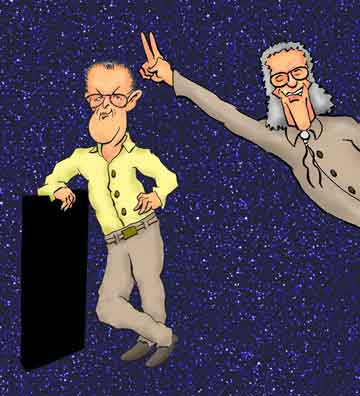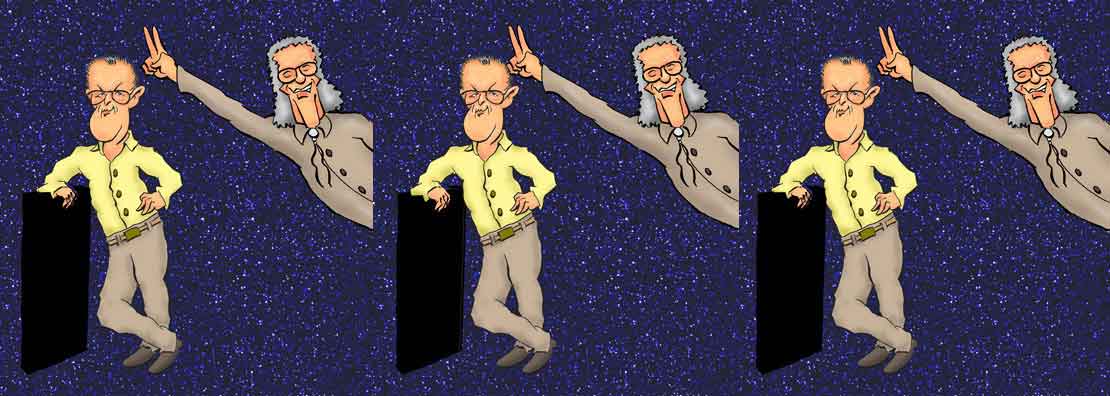Arthur C. Clarke and Isaac Asimov

Arthur C. Clarke and Isaac Asimov
Both were second best.
In the late 1960's, two essays appeared in the Magazine of Fantasy and Science Fiction. The February, 1967 edition carried "Impossible, That's All!" by Isaac Asimov. Then in October, 1968 you could read "Possible, That's All!" by Arthur C. Clarke.
In "Impossible, That's All", Isaac argued that for all the talk of faster than light spacecraft - Star Trek had just begun its first season - reality would always run up against Einstein's Theory of Relativity. The speed of light could never be exceeded, so spacecraft ferrying humans around by breaking the light barrier was, Isaac said, impossible, that's all.
Arthur took exception. He pointed out that Einstein's theory simply said that traveling at the speed of light was not permitted. Arthur added that now familiar concepts such as the space-time distortions, wormholes, and lines straighter-than-straight were not ruled out by the Theory of Relativity. Although faster than light travel would end up using strange concepts like negative mass or imaginary (complex) velocities, strange concepts do not mean they cannot be real concepts.
Traveling faster than light? It was, Arthur said, possible, that's all!
We should realize that Isaac did not necessarily contradict Arthur. And Isaac readily admitted his conclusions were not solely based on science but also on his philosophy that there was symmetry to the universe and that one of nature's most fundamental laws was "You can't win."
Isaac said he believed that even if you managed to exceed the speed of light, you would find yourself in an alternative Universe (often equated with being in "another dimension" in science fiction stories and television shows). But this universe would be physically indistinguishable from the one you came from. And worse of all, you wouldn't be any closer to where you wanted to go.
Of course, the idea of being in another dimension arises from being able to represent higher dimensions in a reference frame of lesser dimensions. For instance, there are a number of ways to represent a three dimensional object on a two dimensional page (for one technique, just click here or on the image at right).
Today, though, the "other dimension" idea - as depicted in Robert Heinlein's Stranger in a Strange Land - would probably be written as being a specific instance of the Many Worlds Hypothesis in which each event of one world splits into many alternative outcomes producing new worlds. The Many Worlds Hypothesis is taken literally (and seriously) by a number of reputable scientists although other scientists - of equal reputation - think it's horse hockey, poppycock, and bullshine.
Despite their disagreements, Arthur and Isaac were good friends. They came to a "treaty" (while sharing a taxi in New York) that Isaac was the best science writer and the second best science fiction writer while Arthur was the best science fiction writer and the second best science writer. So when Arthur published his book Report on Planet Three he wrote: "In accordance with the terms of the Clarke-Asimov treaty, the second-best science writer dedicates this book to the second-best science-fiction writer."
The Clarke-Asimov Treaty seems strange given that Isaac was the True Titan of Science Fiction of the 20th century. And Arthur was the author of groundbreaking scientific works, Interplanetary Flight, and The Conquest of Space. So shouldn't it be the other way around?
No, we have to agree with the original Treaty. Isaac's science books cover virtually all topics - from physics to chemistry to math to biology to sociology, and Isaac even branched into non-scientific topics like Shakespearean scholarship and Biblical studies. Issac was able to explain even complex subjects like wave-particle duality by using simple analogies from everyday life. Arthur's science writings, on the other hand, were largely restricted to space exploration, astrophysics, and oceanography.
Isaac, as everyone knows, was associate professor of biochemistry at Boston University's School of Medicine. It's a comment on his times (and our own) that today he would probably not have attained the position and become the Titan of Science Fiction of the 20th century. But Isaac's time as an assistant professor was the era before publish-or-perish ruled the college system. Although Isaac co-authored a textbook on biochemistry and did contribute original research papers, eventually he ended up abandoning research and even teaching classes. He felt that his writings on science more than justified his university salary. "As a researcher," he told a college administrator, "I am only average. But as a teacher, I am exceptional!" Modesty was not Isaac's strong point.
At that point, the administrator did, in fact, try to get Isaac bounced from the department. But all that could be done was to yank Isaac's salary. He could not be deprived of his tenured professorship without cause. Isaac was Associate Professor of Biochemistry at Boston University for the rest of his life.
But Isaac never, he tells us, wrote science fiction on university time, and as far as rating their fiction writing, stylistically we have to give the nod to Arthur. His dialogue is a bit more natural and the narratives run a bit smoother.
However, Isaac's influence on science fiction literature - influence which largely arose from his opera magna, The Foundation Trilogy (Foundation, Foundation and Empire, and Second Foundation) as well as his robot stories and novels - is certainly greater than Arthur's. We also have to acknowledge that Isaac was probably the true inventor of that mixed literature genre - the science fiction mystery.
Today, though, there are cracks in Arthur's and Issac's writings - cracks that we see in almost all science fiction written from the 20th century. The sad truth is no science fiction writer (or anyone else) really knows what the future will bring.
Eventually even the most well-thought plots and fictional universes will seem quaint with anachronisms peppering the plots. Why are people living in Star Date 4523.3 wearing 1960's hair styles? Why is the Soviet Union still around in 2001? Why are companies past the Millennium still using logos that were discarded in the 1980's?
Nothing ruins a futurist's forecasts worse than the future. As late as the 1950's, there was still serious speculation that some kind of critters might be living on Mars, and some people thought there really could be canali on the surface. But beginning in the 1960's real spaceships began to reach the Moon and other planets, and it became clear that stories like Ray Bradbury's The Martian Chronicles were not - as Eliza Doolittle said - bloody likely.
In 1959 Russia's Luna 3 proved that the far side of the moon did not conceal any advanced civilizations. Then in 1962, Mariner 3 showed that Venus, far from being a well-watered twin of the Earth, was an inferno with surface temperatures above 800 degrees Fahrenheit and that the atmosphere is over 95 % carbon dioxide. Soviet landings on Mars in the early 1970's as well as in the US's Viking 1 landing in 1976 proved the Red Planet was the Bare Planet. Despite periodic discoveries that experts tell us might be a sign that life once existed on Mars, the discoveries have always had a more reasonable explanation such as being microscopic inorganic structures that can formed without a living organism.
Today the idea that there are men (and women) from the Moon or Mars has pretty much vanished from the literature. With each new planetary probe there wasn't much else to do but to move science fiction plots to even further off planets and to places where no man has boldly gone before and to galaxies far, far away.
Without doubt the biggest - or at least the most famous - from all of Arthur's oeuvre was the novel, 2001: A Space Odyssey. This novel, together with the homophonomorphic movie, was considered a turning point in science fiction, both in literature and motion pictures.
Hoping not to sound too curmudgeonly, the fair minded critic can certainly find fault with the movie. True, the cinematography was very good, but the acting OK at best. And seeing what were hailed as fantastic, amazing, spectacular, and groundbreaking special effects was like watching a stage magician performing tricks where you could see how they were done. The "nebulae" we see flashing by the spacecraft were clearly optical prints of films shot from an airplane flying over terrestrial landscapes or of flowing dissimilar liquids. The scenes depicting weightlessness and the effects of centrifugal force - sorry, that centripetal force - were clearly created by simply tilting the camera or having it set in a rotating drum.
Not that there were no prescient elements about the film. We saw a ubiquity of desktop terminals and handheld devices that are virtually identical to what you can buy today. In the book Arthur also had his characters using what was the Internet in everything but name.
On the other hand, there was one obviously massive SNAFU with the movie. And it was a literary, not scientific problem. It was simply impossible to put the plot of Arthur's book into a coherent script.
In fact the whole script was a hash. Just what was that black slab and what was happening when the people on the moon put their hands against their ears (or rather aside their helmets)? What did it mean when the astronaut went motionless and strange forms went streaking by only for him to end up in a fancy Louis XVI furnished room? So it's no surprise that people walked out of the theaters saying "Just what the heck was going on?"
But those who had first read the novel had no problem. Like all good novelists, Arthur provided explanations of what was going on. Instead the biggest surprise for those who read the book first and saw the movie second was which planet the astronaut's were headed for.
You see, Arthur wrote the novel independently of Stanley Kubrick writing his screenplay. So there were differences in the story, the major divergence being that Arthur had the astronauts traveling to Saturn, and Stanley had them stop at Jupiter. But when Arthur wrote the sequel - 2010: Odyssey Two - he ignored his earlier plot and had the characters "return" to Jupiter.

J. R. R. Tolkien
Don't destroy the magic.
Throughout their long careers Isaac and Arthur produced such an impressive number of books that it was inevitable that they would capitalize on their popularity by penning a number of sequels. Although the sequels were motivated by admirable intent - to answer questions debated by their fans and to tie their works into a coherent whole - the sequels were neither author's best works. Sadly - and by reading the books of other writers as well - it's become all too clear that attempts to add after-the-fact coherence to a series of stories written with no intended connection inevitably produces books that are very nearly unintended self-satire.
Authors might take heed when tying together their loose ends from none other than J. R. R. Tolkien after he wrote about his own magnus opus The Lord of the Rings. In a reply to a reader, Ronald mentioned that much of the popularity of the book was from the hints it provided of an earlier history of his imaginary world.
Part of the attraction of The L(ord). (of the) R(ings). is, I think, due to the glimpses of a large history in the background: an attraction like that of viewing far off an unvisited island, or seeing the towers of a distant city gleaming in a sunlit mist. To go there is to destroy the magic..."
Ironically, by issuing Ronald's other writings after he died - including earlier and partial drafts - his publisher did indeed destroy much of the magic. Maybe this is why we increasingly find Ronald's books - including The Lord of the Rings - on the "Books-That-People-Buy-But-Don't-Read" lists.
Ironically, the science fiction stories of Arthur and Isaac that stands up best are where the science is subordinate to the story. That includes works that were not intended to be taken too seriously, such as Isaac's "A Loint of Paw" and "The Immortal Bard" and more extensively in Arthur's Tales from the White Hart. Not science fiction in the usual sense, Tales from the White Hart features the recurring character Harry Purvis, an English scientist whose unbelievable stories about scientific discoveries keep his fellow patrons of the White Hart pub guessing whether Harry is serious or not. There are, of course, references that date the stories - such as massive computers filled with vacuum tubes and transistors - but all in all the stories hold up quite well.
Another faux pas was when Arthur predicted the Soviets would reach the Moon ahead of the Americans - something that most people were predicting in the early 60's. But as of this writing no Russian astronauts (usually called cosmonauts) have yet to set foot on the lunar surface.
Other overly enthusiastic predictions in 2001: A Space Odyssey was Arthur had his astronauts "hibernating" on long voyages, space stations complete with restaurants and traveler's lounges orbiting the Earth, and permanent colonies on the moon - forecasts which seem now incredibly optimistic. The truth is that such advancement of space travel and colonization will require enormous support resources - something that taxpayers of countries today are not now willing to foot.
One atypical distinction for Arthur compared to other science fiction or science writers is that he received a science award from the Franklin Institute of Philadelphia. In 1963, he was awarded the Institute's Stuart Ballantine Medal. This was not for his writing per se but for his proposal of satellite communication.
Arthur was, in fact, the first to propose geostationary satellites - that is satellites orbiting about 22,000 miles above the surface of the earth and traveling at nearly 7000 miles per hour. The net result is they remain (pretty much) above the same spot of the earth's surface and can serve as permanent and uninterrupted relays for wireless communication.
We see, then, that Arthur's later fame as an uncannily accurate futurist was to some degree self-fulfilling. There was certainly nothing mystical about his ability. He just kept himself well-informed and said what he thought would happen.
Isaac was also something of a futurist. His stories predicted that robots would become routine substitutes for human workers and that their use would produce large classes of unemployed that the government herds into barracks and who have to perform menial labor for the massive underground cities. This dire scenario hasn't (yet) emerged. But it was Isaac who coined the word robotics for the field of designing and creating robots.
But no futurists get everything right. Isaac predicted - and explained why - robots would be anthropoid in design rather than be tailor-made for specific tasks. His robots with their positronic brains were also completely sentient beings.
On the other hand today's robots used in manufacturing are computer controlled machines - and that's what they look like. Anthropoid robots are mostly prohibitively expensive novelty items used for demonstration and research purposes. They cannot even come close to doing everything a person can. They certainly can't think any more than can a turbine or electrical circuits in your home.
Sometimes the old sci-fi stories have plot elements that were so contradictory that we are surprised the author's didn't catch them. Although in one of Isaac's robot-detective novels The Caves of Steel - a great book, by the way - Daneel Olivaw, the extra-terrestrial humanoid robot, expresses surprise that the New York City police department has a computer that was so large and massive that it could - get this - actually list the city's inhabitants who were arrested for certain crimes and even remove from the list people who have died. Such a computer the robot says is far more massive and complex than the computers on his own planet.
So we have planets that you can only reach by faster than light travel and whose technology can create robots that would fool the average Earth inhabitant into thinking they're human. But those same planets don't have computers that can even handle simple database operations.
Not, as Eliza said ...
References
"Impossible, That's All!", Isaac Asimov, The Magazine of Fantasy and Science Fiction, February, 1967, pp. 113 - 123. Reprinted in Science, Numbers, and I, Doubleday, 1968.
"Possible, That's All!", Arthur C. Clarke, The Magazine of Fantasy and Science Fiction, October 1968, pp. 63 - 69. Reprinted in Greetings, Carbon-Based Bipeds! Collected Essays, 1934-1998, Arthur C. Clarke, St. Martin's Press, 2000.
"The Decades-Long Flame War Between Arthur C. Clarke and Isaac Asimov", Adam Rowe, Barnes and Nobles Science Fiction, April 1, 2015.
"A Loint of Paw", Isaac Asimov, The Magazine of Fantasy and Science Fiction, August 1957, pp. 130 - 132. Reprinted in Asimov's Mysteries, Doubleday, 1968
Tales From the White Hart, Arthur C. Clarke, Ballantine, 1957
"The 1945 Proposal by Arthur C. Clarke for Geostationary Satellite Communications", Kavan U. Ratnatunga, Lakdiva, 2006.
